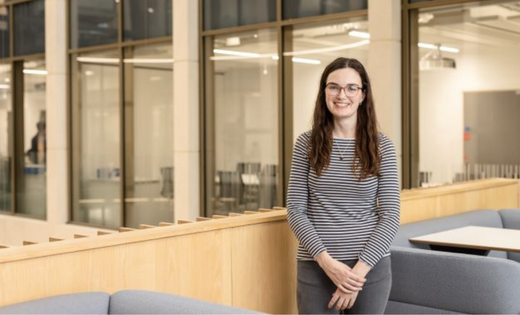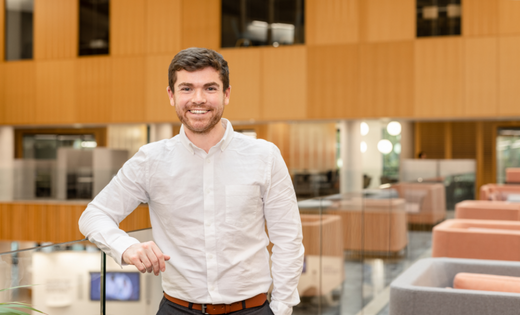Researchers benefitting from new medical fellowship
Postdoctoral researchers Amanda MacCannell and Chris Trevelyan are the first recipients of the ten-year Summerhayes Fellowship.
Targeted at addressing major medical challenges in the Faculties of Medicine and Health and Biological Sciences, the Summerhayes Fellows programme gives brilliant post-doctoral researchers the opportunity to take a fresh approach to age-old medical questions. It is a gift that was secured by the University’s Advancement Team, and funded thanks to a generous donation by alumnus Clive Summerhayes (Civil Engineering and Industrial Relations 1962) and his wife Pauline Summerhayes.
The first two fellows, Drs Amanda MacCannell and Chris Trevelyan, began their work last year.
They are examining life at the molecular level, using the armoury of research tools in our Faculties of Medicine and Health and Biological Sciences to gain an understanding of the cellular processes driving medical conditions. Our close partnership with Leeds Teaching Hospitals Trust gives them access to patient groups, blood and tissue samples – and the expertise of clinicians whose working lives are driven by a passion to help people beat life-limiting diseases.
As newly-qualified PhDs, Amanda and Chris are at a career stage where only limited opportunities may be available, and where institutions can lose outstanding talent. The funding and support secured by the Advancement team will ensure that these exceptionally talented young academics remain at the University.
The benefits of exercise – in a drug

Amanda MacCannell’s research could one day lead to a drug that replicates the benefits of physical exercise.
The benefits of an active lifestyle are well known – from reduced weight and stronger muscles through to improved fitness and mental well-being. Medically, physical exercise contributes to lower blood pressure and the prevention of muscle wastage. Exercise supports our recovery from illness and helps prevent the onset of conditions such as type-2 diabetes, cardiovascular disease, and even some cancers.
In contrast, people who have more sedentary lives – often because they have conditions which prevent them exercising – take longer to recover from illness and may be more vulnerable to these life-limiting diseases.
Amanda’s research focuses on the molecular processes at work when we exercise, in the hope of sharing these benefits with disabled or bed-ridden people unable to enjoy an active lifestyle. “If we can figure out the molecular signals which give us the beneficial effect from exercise, we could design a drug to target and replicate them,” she said.
Amanda is examining a protein called LRG1, which is secreted from the liver and from fat tissue – and is closely linked to physical activity. “We need this protein for our muscles to function, and sedentary patients have less of it than active patients,” Amanda explained. “We don’t know why – it could be that exercise helps us produce more LRG1, or greater levels of it encourage us to exercise.”
By studying the nature of the protein and what it does in our cells, she is exploring whether it could be harnessed to prevent muscle wastage and disease for those who don’t exercise. Potentially, a drug could prompt the body to synthesise more of the protein. To reach that point, Amanda must delve deeper into the protein’s behaviour at the molecular level, to understand how it interacts both within cells and the entire human body.
The work draws on the partnership with Leeds Teaching Hospitals Trust, giving Amanda easy access to blood and tissue samples for use in her research – and to people being treated for conditions such as diabetes and heart disease.
“This opportunity has allowed me to explore research only available in Leeds,” she said.
Unlocking the secrets of a deadly cancer

Liver cancer is responsible for about 5,800 deaths a year in the UK. Chris Trevelyan’s research is focused on its early diagnosis and treatment.
Many people who develop the cancer already have a liver disease such as hepatitis or cirrhosis. Often the symptoms of these are so similar that the patient fails to realise their condition has changed – and so may not come forward, or may not be referred for cancer testing. Even when tested, diagnosis among men can be slow because the biomarker currently used for liver cancer also indicates testicular cancer.
Central to Chris’s work is ribonucleic acid (RNA) which delivers instructions held in our DNA to create the proteins that run biological processes at work in the body. Chris is studying tiny biological hoops called circular RNA (circRNA) in the hope that these could open the door to quicker diagnosis and new treatments for liver cancer.
Looking at liver cancer patients undergoing treatment in St James’s University Hospital, Chris is searching for a marked difference in circRNA levels between those who respond to the treatment – and those who fail to do so. If Chris finds that circRNAs are biomarkers for liver cancer, they could unlock a simple, quick and non-invasive way to spot a disease that is currently difficult to diagnose. Blood, urine or saliva could be screened in clinics or GP surgeries, instead of patients waiting for an invasive biopsy.
The research could one day go further. By manipulating what they do naturally, circRNAs could be harnessed to offer a more accurate personalised prognosis of the disease – and even deliver new treatments.
Posted in: University news